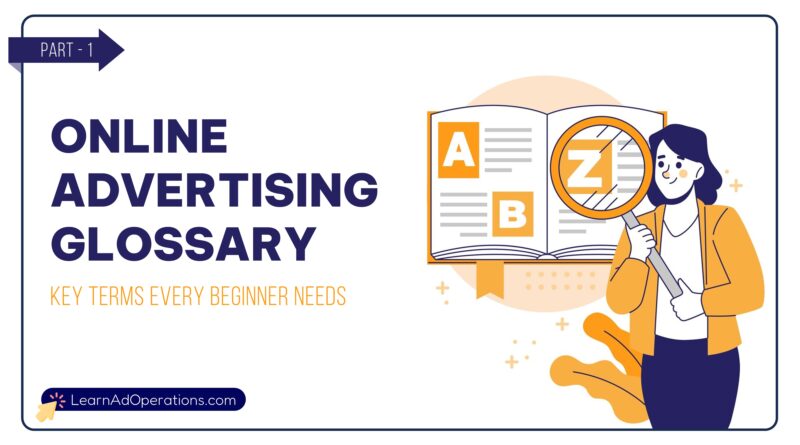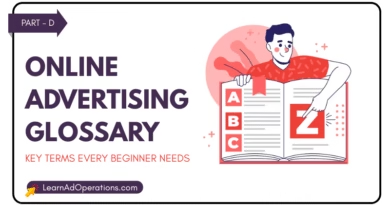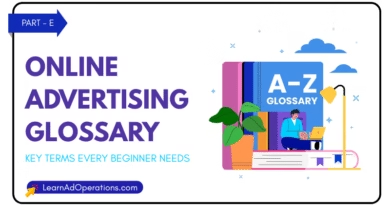Online Advertising Glossary: Digital Marketing Terms for Beginners
In the fast-paced world of digital marketing, mastering online advertising jargon is crucial for beginners aiming to excel. Our extensive Online Advertising Glossary is your ultimate resource for understanding digital advertising terms and concepts from A to Z.
Whether you’re exploring programmatic advertising, eCommerce advertising, performance marketing, or search engine marketing (SEM), this guide will help you quickly and effectively grasp the most important online advertising terminology.
By familiarizing yourself with these key terms, you’ll not only enhance your knowledge of digital advertising but also boost your ability to create successful digital marketing strategies. Start navigating the complex landscape of online ads and improve your marketing acumen with our detailed glossary today!
A
Above the fold (ATF): Refers to the top half of a page or portion of a website that is visible in a browser when a page first loads, before any scrolling occurs. Generally, a premium space where a large number of users will see the content and ads.
Acquisition: Refers to the gain or addition of new visitors to a website.
Active IDs: Represents known active users from all IDs that are received by The Trade Desk within a data segment.
Activity: The history of all changes made.
Ad agency: The business that manages the design, creation, and development of advertisements. Typically works with media agencies to strategically place advertisements so that targeted consumers see the ad.
Ad environment: The browsing environment in which various types of ads can be served, including web, mobile-optimized web, and in-app environments.
Ad exchange: Service that connects publishers, advertisers, and demand-side platforms, and conducts auctions among bidders per impression.
Ad format: The size of an ad (width x height), generally measured in pixels.
Ad fraud: The practice of falsifying aspects of ad serving for financial gain, including search and click-ad fraud.
Ad group: A campaign strategy that enables marketers to assemble targeting strategies to specify when, where, and how to serve ads. They can manage budgets, goals, creatives, site lists, inventory, and viewability, as well as targeting options for audiences, devices, locations, languages, times of day, and video adjustments across ad groups.
Ad inventory: The amount and types of ad space that a website can offer to advertisers for purchase; typically defined by size, format, location, and available impressions.
Ad network: The company that connects advertisers with publishers by matching supply of ad inventory with demands for ad placement.
Ad tech: Any digital tool, software, or service that is used to help advertisers manage and analyze their ad campaigns.
Ad Verification: The service or system that verifies whether a campaign has been carried out as intended, ensuring ads appear on the correct websites and reach the intended audience.
Ad-supported video on demand (AVOD): Content services like YouTube and Hulu that offer content for free or reduced subscription fees.
Addressable TV: A strategy of placing different ads on TVs in households that are watching the same TV program.
ads.txt: A text file introduced by the Interactive Advertising Bureau that participating publishers attach to their websites that enables transparency by allowing the creation of public records of authorized sellers of their inventory.
Are you looking to learn Online Advertising jargons? Here is the comprehensive guide for beginners to learn digital marketing key terms from our Online Advertising Glossary.
Advanced TV: A bucket term for all the ways marketers can serve ads to their TV-viewing audiences, from streaming services to addressable TV and across devices.
Advertiser: A company, group, or brand that buys ad space online in order to sell products or services to a target audience.
AI-powered: Tools and systems that use artificial intelligence and machine learning to automate tasks.
Allow list: A list of websites that an advertiser has deemed acceptable to display ads on.
Angel investor: A high-net-worth individual or entrepreneur who provides financial backing for startups in exchange for ownership or equity in a company.
API: A set of access points and tools that enable developers to build custom workflows and applications that can access certain features and data.
Aspect ratio: The width of a video creative to its height. Used for developing video and TV advertisements.
Attribution: The process of determining credit for a conversion, or desired action a customer takes depending on the advertiser’s preference. Includes identifying steps a user takes before converting, placing value on each step, and assigning credit to either single or multiple steps. Helps better understand what drives customers toward conversion.
Attribution window: The period of time after a click or impression occurs that a conversion is tracked for credit to the click or impression.
Auction: An online marketplace where advertisers place real-time bids to buy publishers’ ad inventory.
Audible and visible on complete (AVOC): The percentage of impressions where an ad was served to a human and seen and heard in its entirety.
Audience Accelerator: A data solution that aggregates TV ad exposure and viewership data from a multitude of partners, including multichannel video programming distributors and over-the-top providers. Data can be leveraged to inform programmatic strategies like focusing spend on expanding reach to net-new households and maximizing audience penetration.
Audience Booster: A feature that automatically optimizes campaign audiences by adding high-performing segments to audiences most likely to convert.
Audience Excluder: A feature that enables our AI, Koa, to use lookalike model data to update audiences least likely to convert, removing them from the marketer’s audience. Highly recommended for conversion-based campaigns and for contextual strategies.
Audience Predictor: A feature that enables artificial intelligence to use lookalike model data to create and continuously update an audience of users who are most likely to convert, and target them in the marketer’s audience.
Audio: The digital streaming of audio content, such as music, talk shows, and podcasts, through platforms like Spotify and Pandora.
Audio advertising: The process of inserting ads into audio content.
Auto Allocator: A budget-optimization feature that reduces the time and effort it takes to manage spend through either automatic prioritization or manual prioritization. Empowers our AI, Koa, to prioritize ad groups based on performance and direct spend to better-performing ad groups first, before assigning remaining budget to lower-performing groups. Manual prioritization allows regulating how ad groups are prioritized and how spend is allocated.
Automatic content recognition (ACR): Used to identify content played on a media device or present within a media file.
Available impressions: The ad opportunities that are open to bid on.
Average Rating: The percentage of people viewing a program compared to the total population of TV viewers.
Awareness: How familiar customers are with a brand.
Awareness campaign: An ad campaign that works to increase brand visibility and recognition by educating potential customers on the existence of a brand.
Source: The TradeDesk




